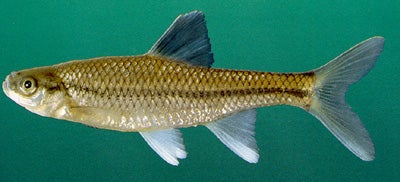PUGNOSE MINNOW
SCIENTIFIC NAME: Opsopoeodus emiliae
CHARACTERISTICS: This species has a moderately deep, compressed body, a small head, a blunt snout, and a small, almost vertical mouth. Body scales are heavily outlined with melanophores, giving them a diamond shaped appearance. A slender, dark lateral band extends from the gill opening to the caudal fin base. The dorsal fin of breeding individuals is heavily pigmented except for a clear white "window" in the middle. The caudal, anal, and paired fin membranes are pigmented and may be faintly shaded with pink or red. The tips of the paired fins and anal fin are usually white.
ADULT SIZE: 1.6 to 2.6 in (40 to 65 mm)
DISTRIBUTION: Gilbert and Bailey (1972) recognize two subspecies of pugnose minnows. Opsopoeodus e. emiliae occurs from Texas east to South Carolina and north through the Mississippi basin to Wisconsin, while O. e. pennisularis occurs from the St. Johns drainage in the Okeechobee River in Florida. The pugnose minnow is widespread in the Mobile basin below the Fall Line, somewhat rare in coastal drainages, and only sporadically encountered in the Tennessee River drainage.
HABITAT AND BIOLOGY: Opsopoeodus emiliae is most often associated with sluggish, clear, vegetated waters over muddy or silty bottoms habitats that occur in impoundments and some Coastal plain streams. It reportedly feeds on midge larvae, microcrustaceans. filamentous algae, water mites, and fish eggs (McLane, 1995), although the position of its mouths suggests that it is a surface feeder. Spawning occurs from May to July and in warm southern waters may extend from late winter to early fall. Using a boat electrofisher, we have collect individuals in "high" spawning conditions from aquatic vegetation beds in south Alabama, and the field notes of R. D. Suttkus report O. emiliae spawning low in the water column. In contrast, Page and Johnston (1990a) report spawning on the underside of rocks for aquarium-held individuals. Whatever their spawning condition, males apparently attract the attention of females by rapidly fluttering their dorsal fins.
REMARKS: The type locality of the pugnose minnow is Horsehunter Creek, a tributary of the Noxubee River near Macon, Noxubee County Mississippi.
ORIGINAL DESCRIPTION: The pugnose minnow was described by Hay in 1881.
ETYMOLOGY:
Opsopoeodus means broadly interpreted "teeth for dainty feeding".
Emiliae means in honor of Emily Hay, wife of Oliver P. Hay describer of the species.
The copyrighted information above is from Fishes of Alabama and the Mobile Basin.






